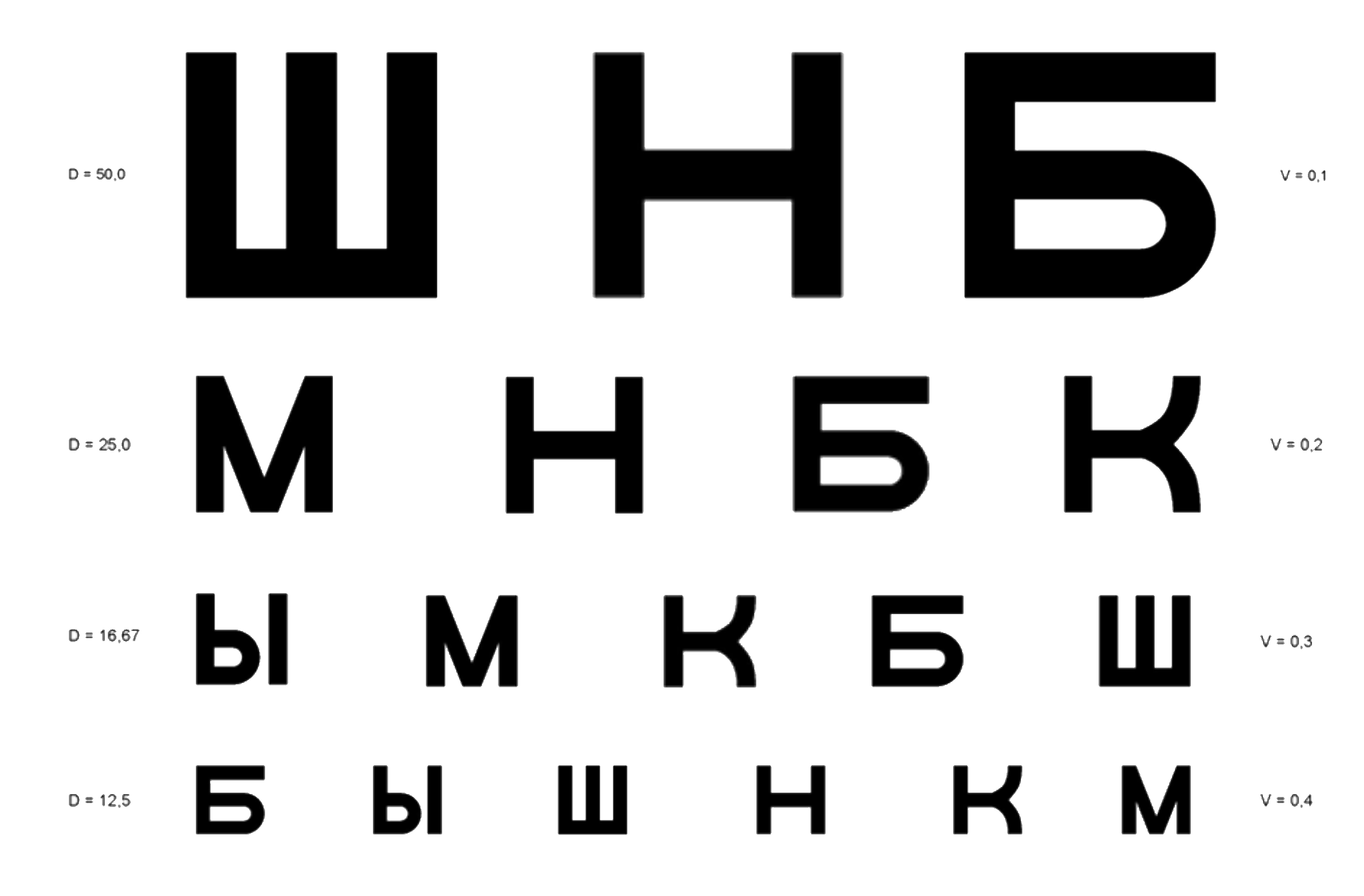Golovin–Sivtsev Table on:
[Wikipedia]
[Google]
[Amazon]
The Golovin–Sivtsev table () is a standardized table for testing Some information on Golovin–Sivtsev table
— that website as a whole doesn't seem to be reliable, but it seems to present reliable information on Golovin-Sivtsev table dimensions The left part consists of series of the Black and white pattern identification at 1 arcminute angle is considered to be visual acuity of 1.0, which is around 1 mm per 3.44 m distance. A character 7 mm in size has 1.4 mm pattern gaps, so over the 5 m view distance it gives an angle of around 1 arcminutes (atan(0.007/5/5)≈0.963').
There are two types of the table. The first is shorter, second is longer version.
Black and white pattern identification at 1 arcminute angle is considered to be visual acuity of 1.0, which is around 1 mm per 3.44 m distance. A character 7 mm in size has 1.4 mm pattern gaps, so over the 5 m view distance it gives an angle of around 1 arcminutes (atan(0.007/5/5)≈0.963').
There are two types of the table. The first is shorter, second is longer version.
visual acuity
Visual acuity (VA) commonly refers to the clarity of visual perception, vision, but technically rates an animal's ability to recognize small details with precision. Visual acuity depends on optical and neural factors. Optical factors of the eye ...
, which was developed in 1923 by Soviet ophthalmologist
Ophthalmology (, ) is the branch of medicine that deals with the diagnosis, treatment, and surgery of eye diseases and disorders.
An ophthalmologist is a physician who undergoes subspecialty training in medical and surgical eye care. Following a ...
s Sergei Golovin and D. A. Sivtsev. In the USSR
The Union of Soviet Socialist Republics. (USSR), commonly known as the Soviet Union, was a List of former transcontinental countries#Since 1700, transcontinental country that spanned much of Eurasia from 1922 until Dissolution of the Soviet ...
, it was the most common table of its kind, and its use is still widespread in several post-Soviet states.
The table consists of two parts with 12 rows each, representing visual acuity values between 0.1 and 2.0.— that website as a whole doesn't seem to be reliable, but it seems to present reliable information on Golovin-Sivtsev table dimensions The left part consists of series of the
Cyrillic
The Cyrillic script ( ) is a writing system used for various languages across Eurasia. It is the designated national script in various Slavic, Turkic, Mongolic, Uralic, Caucasian and Iranic-speaking countries in Southeastern Europe, Ea ...
letters Ш, Б, М, Н, К, Ы, and И in a definite order, and the right part of the table consists of a series of Landolt C symbols. The width of each character is equal to its height, and the contours have standard gaps of the overall size.
The value ''D'', indicated to the left of each row, gives the distance in meters from which a person with a visual acuity of 1.0 can read the corresponding row. The value ''V'', indicated to the right, gives the minimum visual acuity needed to read the row from a distance of 5 meters. The first row contains symbols 70 mm in size (V = 0.1); the second row, 35 mm; the bottom third row, 7 mm (V = 1.0); the bottom row, 3.5 mm (V = 2.0).
 Black and white pattern identification at 1 arcminute angle is considered to be visual acuity of 1.0, which is around 1 mm per 3.44 m distance. A character 7 mm in size has 1.4 mm pattern gaps, so over the 5 m view distance it gives an angle of around 1 arcminutes (atan(0.007/5/5)≈0.963').
There are two types of the table. The first is shorter, second is longer version.
Black and white pattern identification at 1 arcminute angle is considered to be visual acuity of 1.0, which is around 1 mm per 3.44 m distance. A character 7 mm in size has 1.4 mm pattern gaps, so over the 5 m view distance it gives an angle of around 1 arcminutes (atan(0.007/5/5)≈0.963').
There are two types of the table. The first is shorter, second is longer version.
References
{{DEFAULTSORT:Golovin-Sivtsev table Ophthalmology Medical signs